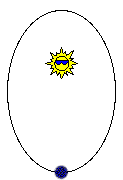|
|
|
|
Calendars were crucial to solving the second half of the latitude problem: knowing exactly where the sun was in relationship to the earth on every day of the year.Here's how it worked
The earth moves three different ways at the same time.

|
|

|
 Above, a page from Zacuto's Rules for the Spring of 1473. |
|
It moves around the sun every year (or to be precise, every 365 days, 5 hours, and 42 minutes). Sometimes the top (northern hemisphere receives the most sun (northern hemisphere summer); sometimes the southern hemisphere receives the most. A mathematical equation can be used to predict where the sun will be on everyday of the year. But an accurate solar calendar is indispensable, or otherwise the days and position of the sun don't match up. |
It spins like a top every twenty-four hours (every day). |
Finally it slowly moves in a tiny circle on its axis. While some scientists call this motion wobbling, it is more like a very slow circle that takes 26,000 years to complete. While tracing this small circle, the earth remains tilted at 23.5 degrees. |
A Jewish scientist named Abraham Zacuto created the first comprehensive table combining the accurate date in the solar year, the sun's position relative to the earth's seasons, and the height of the midday sun above the horizon. His book, called Rules for the Astrolabe combined all this information to produce scientifically accurate latitude. It was copied and used by other Europeans to determine latitude for the next hundred years.
|
The first problem was to accurately measure the height of the midday sun above the horizon. To learn about how they solved the first problem check out the Astrolabe page
To see an animated picture of the earth (correctly tilted) as it travels around the sun see The Orbiting Tilted Earth
To see a stationary picture here is the Tilted Earth
To learn more about the slowly moving earth a surprising source is an astrology page Earth Facts Or learn more from a conventional source Fourmilab's Help